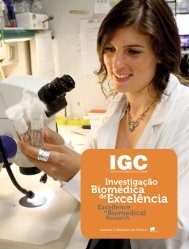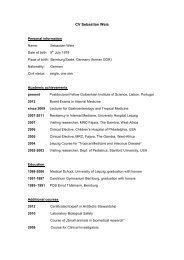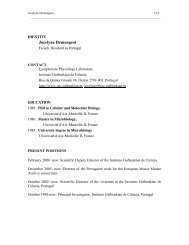organisation - the Instituto Gulbenkian de Ciência
organisation - the Instituto Gulbenkian de Ciência
organisation - the Instituto Gulbenkian de Ciência
- No tags were found...
Create successful ePaper yourself
Turn your PDF publications into a flip-book with our unique Google optimized e-Paper software.
NETWORK<br />
MODELLING<br />
Claudine Chaouiya Research Fellow<br />
PhD in Computer Science, Université <strong>de</strong> Nice Sophie Antipolis, 1992<br />
Assistant professor - Research Associate, Université Aix-Marseille II, France<br />
Research Fellow at <strong>the</strong> IGC since 2009<br />
link to external website<br />
Major breakthroughs in molecular biology, genomics and functional genomics<br />
allow <strong>the</strong> <strong>de</strong>lineation of ever-larger interaction networks controlling cellular<br />
processes. To assess <strong>the</strong> complex behaviours induced by <strong>the</strong>se networks, <strong>de</strong>dicated<br />
ma<strong>the</strong>matical and computational tools are crucial. In this context, our<br />
major goal is to <strong>de</strong>velop generic and efficient means for <strong>the</strong> qualitative mo<strong>de</strong>lling<br />
and analysis of regulatory networks involving hundreds of components and<br />
diverse regulatory interactions, including inter-cellular signalling. Our strategy<br />
is threefold:<br />
1. Define formal methods to assess dynamical properties of regulatory network<br />
discrete mo<strong>de</strong>ls;<br />
2. Implement <strong>the</strong>se methods ei<strong>the</strong>r in GINsim (our software <strong>de</strong>dicated to <strong>the</strong><br />
logical mo<strong>de</strong>lling of regulatory networks), or in standalone programmes;<br />
3. In collaboration with biologists, challenge our methodological <strong>de</strong>velopments<br />
with real case applications, specifying and analysing mo<strong>de</strong>ls for <strong>the</strong> control<br />
of cell proliferation and differentiation.<br />
GROUP MEMBERS<br />
Pedro T. Monteiro (Postdoc, started in April)<br />
Nuno D. Men<strong>de</strong>s (Postdoc, started in July)<br />
John Alexan<strong>de</strong>r (Technician, from April to November)<br />
COLLABORATORS<br />
Elisabeth Remy (Institut e Mathématiques <strong>de</strong> Luminy, France)<br />
FUNDING<br />
Fundação para a Ciência e Tecnologia (FCT), Portugal<br />
French National Research Agency, France<br />
MALIN: Modular mo<strong>de</strong>lling and Analysis of Large biological Interacting networks<br />
Until recently, most ma<strong>the</strong>matical mo<strong>de</strong>ls for concrete molecular networks have<br />
been <strong>de</strong>fined as a unique whole, consi<strong>de</strong>ring networks of a limited size. This<br />
approach is not scalable and has to be modified as networks increase in size<br />
and complexity. The goal of this project is to <strong>de</strong>velop efficient computational<br />
methods to represent and analyse qualitative behaviours of large regulatory<br />
networks, particularly in <strong>the</strong> context of multi-cellular systems. For this, we aim<br />
at <strong>de</strong>fining an appropriate compositional mo<strong>de</strong>lling framework. Importantly, <strong>the</strong><br />
computational <strong>de</strong>velopments envisioned in this project will be confronted and<br />
validated with two challenging concrete biological case studies. The first application<br />
relates to <strong>the</strong> dorsal appendage morphogenesis in <strong>the</strong> Drosophila egg,<br />
where cells communicate within a structured topology. The second case study<br />
consi<strong>de</strong>rs circulating peripheral immune cells and <strong>de</strong>als with a comprehensive<br />
mo<strong>de</strong>l for T lymphocytes differentiation.<br />
Work on this project led, in 2011, to a publication:<br />
(B. Luna, C. Chaouiya (2011) Adv Int and Soft Comp Vol 93: 293-302.), a fur<strong>the</strong>r<br />
manuscript in press (P. T. Monteiro, C. Chaouiya (in press) Efficient verification<br />
for logical mo<strong>de</strong>ls of regulatory networks. Adv Int and Soft Comp Vol 154).<br />
And two more in preparation:<br />
(N. D. Men<strong>de</strong>s et al. Composition and abstraction of iterated logical regulatory<br />
modules using process algebras; A. Fauré et al. Dorsal patterning of <strong>the</strong> Drosophila<br />
eggshell).<br />
CALAMAR: COMPOSITIONAL MODELLING AND ANALYSIS OF LARGE MOLECULAR<br />
REGULATORY NETWORKS - APPLICATION TO THE CONTROL OF HUMAN CELL<br />
PROLIFERATION<br />
Appropriate tools for <strong>the</strong> dynamical mo<strong>de</strong>lling, analysis and simulation are<br />
required to <strong>de</strong>lineate <strong>the</strong> functioning of regulatory networks. In this context,<br />
different formalisms can be consi<strong>de</strong>red, from logical (qualitative) mo<strong>de</strong>ls to differential<br />
(quantitative) mo<strong>de</strong>ls. This project intends to <strong>de</strong>velop novel methods<br />
to efficiently represent and analyse <strong>the</strong> behaviour of large regulatory networks.<br />
This challenge will be addressed through <strong>the</strong> conception of computational<br />
methods for network reduction and (<strong>de</strong>)composition (yet keeping track<br />
of essential dynamical properties). Formal relationships between qualitative and<br />
quantitative mo<strong>de</strong>ls will be generated by <strong>the</strong> application of <strong>de</strong>dicated abstraction<br />
techniques. These generic methods will be confronted with a reference<br />
application, namely <strong>the</strong> analysis of a comprehensive map of <strong>the</strong> RB/E2F regulatory<br />
network, which plays a key role in <strong>the</strong> control of human cell proliferation.<br />
In 2011, work on this project led to manuscripts in preparation: Calzone et al.<br />
Ma<strong>the</strong>matical Approach to account for alterations in blad<strong>de</strong>r tumours, and Bereguier<br />
et al. Dynamical analysis of logical mo<strong>de</strong>ls using compressed hierarchical<br />
state transition graphs.<br />
GINsim screenshot displaying <strong>the</strong> logical, integrated mo<strong>de</strong>l of <strong>the</strong> regulatory network<br />
and signalling pathways controlling Th cell differentiation (Naldi et al. PLoS<br />
Comput Biol 6(9): e1000912, 2010).<br />
Directed graph accounting for <strong>the</strong> plasticity of cell subtypes: arrows between cell<br />
lineages <strong>de</strong>note switches elicited by <strong>the</strong> corresponding environment.<br />
IGC ANNUAL REPORT ‘11<br />
RESEARCH FELLOWS<br />
73






